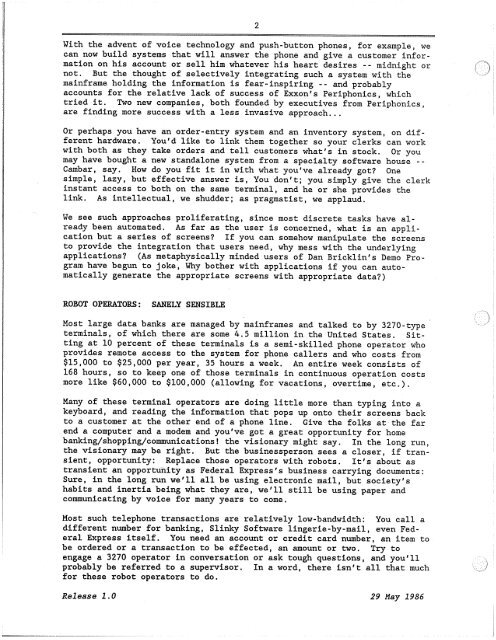EDventure Holdings Inc., 375 Park Avenue, New ... - Cdn.oreilly.com
EDventure Holdings Inc., 375 Park Avenue, New ... - Cdn.oreilly.com
EDventure Holdings Inc., 375 Park Avenue, New ... - Cdn.oreilly.com
Create successful ePaper yourself
Turn your PDF publications into a flip-book with our unique Google optimized e-Paper software.
With the advent of voice technology and push-button phones, for example, we<br />
can now build systems that will answer the phone and give a customer information<br />
on his account or sell him whatever his heart desires -- midnight or<br />
not. But the thought of selectively integrating such a system with the<br />
mainframe holding the information is fear-inspiring -- and probably<br />
accounts for the relative lack of success of Exxon's Periphonics, which<br />
tried it. Two new <strong>com</strong>panies, both founded by executives from Periphonics,<br />
are finding more success with a less invasive approach...<br />
Or perhaps you have an order-entry system and an inventory system, on different<br />
hardware. You'd like to link them together so your clerks can work<br />
with both as they take orders and tell customers what's in stock. Or you<br />
may have bought a new standalone system from a specialty software house --<br />
Cambay , say. How do you fit it in with what you've already got? One<br />
simple, lazy, but effective answer is, You don't; you simply give the clerk<br />
instant access to both on the same terminal, and he or she provides the<br />
link. As intellectual, we shudder; as pragmatist, we applaud.<br />
We see such approaches proliferating, since most discrete tasks have already<br />
been automated. As far as the user is concerned, what is an application<br />
but a series of screens? If you can somehow manipulate the screens<br />
to provide the integration that users need, why mess with the underlying<br />
applications? (As metaphysically minded users of Dan Bricklin's Demo Program<br />
have begun to joke, Why bother with applications if you can automatically<br />
generate the appropriate screens with appropriate data?)<br />
ROBOT OPERATORS: SANELY SENSIBLE<br />
Most large data banks are managed by mainframes and talked to by 3270-type<br />
terminals, of which there are some 4.5 million in the United States. Sitting<br />
at 10 percent of these terminals is a semi-skilled phone operator who<br />
provides remote access to the system for phone callers and who costs from<br />
$15,000 to $25,000 per year, 35 hours a week. An entire week consists of<br />
168 hours, so to keep one of those terminals in continuous operation costs<br />
more like $60,000 to $100,000 (allowing for vacations, overtime, etc.).<br />
Many of these terminal operators are doing little more than typing into a<br />
keyboard, and reading the information that pops up onto their screens back<br />
to a customer at the other end of a phone line. Give the folks at the far<br />
end a <strong>com</strong>puter and a modem and you've got a great opportunity for home<br />
banking/shopping/<strong>com</strong>munications! the visionary might say. In the long run,<br />
the visionary may be right. But the businessperson sees a closer, if transient,<br />
opportunity: Replace those operators with robots. It's about as<br />
transient an opportunity as Federal Express's business carrying documents:<br />
Sure, in the long run we'll all be using electronic mail, but society's<br />
habits and inertia being what they are, we'll still be using paper and<br />
<strong>com</strong>municating by voice for many years to <strong>com</strong>e.<br />
Most such telephone transactions are relatively low-bandwidth: You call a<br />
different number for banking, Slinky Software lingerie-by-mail, even Federal<br />
Express itself. You need an account or credit card number, an item to<br />
be ordered or a transaction to be effected, an amount or two. Try to<br />
engage a 3270 operator in conversation or ask tough questions, and you'll<br />
probably be referred to a supervisor. In a word, there isn't all that much<br />
for these robot operators to do.<br />
Release 1.0 29 May 1986<br />
2
















